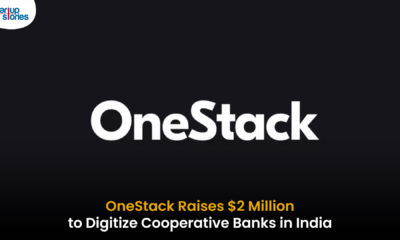Latest News
How This Bangalore Based Augmented Reality Startup Helped Contain Wuhan Covid-19 Outbreak

When news about a new type of virus broke out, the world was not ready for what was to come. The Novel Coronavirus or COVID-19 virus originated in Wuhan province of China. This is now established as the epicenter/epicentrum that quickly paralysed the entire Country, before the virus spread to other countries. Currently, the virus spread to almost every nation on the planet with Italy, Spain, America and Germany being some of the worst affected countries.
The virus seems to have finally subsided in Wuhan and life is slowly returning back to normal. However, when the virus was at its peak, ventilators were the need of the hour. The virus affects the respiratory system and symptoms include difficulty in breathing. Beside the lockdown which played a part in controlling the spread of the virus, ventilators supplied by Huber & Ranner, a German company played a vital role in combating the illness.
However, the technical team could not travel from Germany to Wuhan in order to install the ventilators and demonstrate how to use them. This is where a Bangalore based startup BlinkIn, stepped in to the rescue. According to reports, BlinkIn developed an augmented reality (AR) product named Scotty to provide visual guidance to the technicians in Wuhan. They did this based out of their office in Pocking,Germany. All that the technicians in Wuhan had to do was to click on a link to see a visual demonstration.
Scotty was unlike the other AR products available currently and what makes it special is its simplicity of use and the ease of deployment. Scotty uses WebGL, a JavaScript API(Applications Programming Interface,) to render graphics on to a compatible browser. Chief Executive Officer and co-founder of BlinkIn, Harshavardhan Kumar says “WebGL lets you access a mobile phone’s GPU (graphics processing unit) to run computer vision algorithms. That’s how we bring AR experiences through the Web rather than a mobile app (sic.)” All the technicians at Wuhan had to do was point their phone screen at a ventilator and an installation point, and the AR markers helped indicate how to set the ventilators up as a technician walks through with instructions over voice communication.
The idea behind Scotty was to use lightweight technology in order to provide just enough AR support to get the job done ‘then and there.’ Scotty requires minimal computational power unlike traditional AR, which relies heavily on heavy downloads, graphics processing units and figuring out how to use it.
It is truly wonderful to see how different technologies are adapting to these uncertain times and it will certainly be interesting to see how AR can be merged into other technologies as well in the future.
ALSO READ: Coronavirus Pandemic Testing Startups By Disrupting Supply-Demand
Latest News
Kuku FM’s $200 Million IPO: Mebigo Labs Hires Top Bankers to Lead Public Listing

Kuku FM’s parent company, Mebigo Labs, has hired leading investment banks to prepare for a 200 million dollar IPO in India, marking a major milestone for the country’s digital audio ecosystem. The Mumbai-based company has reportedly appointed Kotak Mahindra Capital, Axis Bank and Morgan Stanley’s India unit to manage the proposed share sale, which is likely to be launched on Indian stock exchanges once key regulatory steps are completed. This move signals strong intent to tap public markets and test investor appetite for subscription-led regional audio platforms in India.
The planned IPO proceeds are expected to help Kuku FM expand its content library, strengthen its regional language offerings and invest in technology to enhance user experience. With a focus on Hindi, Marathi, Tamil and other Indian languages, Kuku FM aims to capture the fast-growing audience in Tier 2 and Tier 3 cities seeking affordable audiobooks, courses and storytelling content. The funds could also provide additional firepower for marketing, partnerships and product innovation, helping the platform compete more aggressively in India’s crowded digital entertainment and creator economy landscape.
Founded in 2018, Kuku FM has built a subscription-driven business model and has reportedly scaled to millions of paying users, backed by multiple funding rounds from prominent investors. Its decision to pursue a 200 million dollar IPO positions it as one of the first major Indian audio platforms to attempt a public listing, potentially paving the way for other podcast and niche content startups to follow. As the IPO process moves forward, Kuku FM’s performance in the public markets will be closely watched as a key indicator of how investors value regional, knowledge-first audio platforms in India’s booming digital economy.
Latest News
Zerodha Reports 23% Profit Decline in FY25 as Revenues Miss Target

Zerodha experienced a challenging FY25, as its revenue fell 11.5% to ₹8,847 crore and net profit dropped 22.9% to ₹4,237 crore. This decline reflects tougher regulatory conditions, lower trading volumes, and increased operational costs in the brokerage market, all of which impacted core earning segments for the company.
Despite these headwinds, Zerodha improved its operating margin to 63.78% and built up significant cash reserves, reporting ₹22,679 crore in bank balances. Salary expenses and director remuneration increased, but disciplined cost controls helped the company maintain profitability and a debt-free balance sheet. The drop in active clients and increased compliance costs further contributed to the profit contraction.
Looking ahead, Zerodha’s resilience is supported by its robust cash position and operational efficiency. Maintaining steady margins, diversifying product offerings, and investing in technology positions the company to withstand future regulatory fluctuations and changing market sentiment reinforcing its status as one of India’s leading brokerage firms.
Latest News
Zoho Pay Debuts as India’s New UPI Challenger, Taking on PhonePe, Paytm, and Google Pay

Zoho Corporation has expanded its fintech portfolio with the launch of Zoho Pay, a UPI-based payments app built to challenge India’s top digital payment giants such as PhonePe, Paytm, and Google Pay. The new app supports peer-to-peer transfers, bill payments, QR-based transactions, and merchant settlements in a streamlined interface. Available as both a standalone app and an integrated feature inside Zoho’s privacy-driven messenger Arattai, Zoho Pay enables users to handle chats and payments in one platform, emphasizing data privacy and Made-in-India innovation.
Through seamless integration with Arattai, Zoho Pay allows users to send or request payments, split expenses, and conduct UPI-based transactions directly in their chat windows. Users can link bank accounts, scan dynamic QR codes, and receive audio confirmations of payments, ensuring speed and security. This design mirrors the simplicity of India’s leading UPI apps but is powered by Zoho’s non-advertising, privacy-first model. The integration aligns with Zoho’s mission to build a self-reliant digital ecosystem, where messaging and money management coexist securely.
In the competitive digital payments market, Zoho Pay differentiates itself through its tight business software integration with apps like Zoho Books, Zoho Payroll, and Zoho Commerce, offering small businesses unified access to payments, billing, and accounting. The company is also expanding its reach with POS devices for merchants featuring UPI QR, card payments, and instant reconciliation tools. With founder Sridhar Vembu’s vision of a ‘Chat + Pay’ ecosystem, Zoho Pay reflects a bold step toward redefining India’s fintech scene with a secure, ad-free, and locally developed alternative to global payment platforms.












Kuwin
November 6, 2025 at 12:18 pm
kuwin sở hữu kho game đa dạng từ slot đến trò chơi bài đổi thưởng, mang đến cho bạn những giây phút giải trí tuyệt vời.
ios超级签
November 8, 2025 at 11:36 am
苹果签名,苹果超级签平台,ios超级签平台ios超级签苹果企业签,苹果超级签,稳定超级签名
MM88
November 9, 2025 at 1:30 pm
Khám phá thế giới giải trí trực tuyến đỉnh cao tại MM88, nơi mang đến những trải nghiệm cá cược thể thao và casino sống động.
iwin
November 16, 2025 at 12:07 pm
iwin – nền tảng game bài đổi thưởng uy tín, nơi bạn có thể thử vận may và tận hưởng nhiều tựa game hấp
J88
November 19, 2025 at 1:26 pm
Đến với J88, bạn sẽ được trải nghiệm dịch vụ cá cược chuyên nghiệp cùng hàng ngàn sự kiện khuyến mãi độc quyền.
MM88
November 29, 2025 at 3:58 am
Với giao diện mượt mà và ưu đãi hấp dẫn, MM88 là lựa chọn lý tưởng cho các tín đồ giải trí trực tuyến.
GO88
November 29, 2025 at 4:29 am
Tham gia cộng đồng game thủ tại Go88 để trải nghiệm các trò chơi bài, poker phổ biến nhất hiện nay.
Robocat Casino App ohne Anmeldung
December 20, 2025 at 3:32 am
Der Anbieter wird von der Glücksspielbehörde des Landes Curaçao überwacht und ist offiziell lizenziert.
Nach dem Willkommenspaket warten die Bonusangebote für Bestandskunden auf dich.
Um zu schauen, wie gut der Anbieter tatsächlich ist,
habe ich mir im Riviera Casino Test die Bonusangebote,
Spiele und Sicherheit näher angeschaut. Die seit 1987 bis zuletzt im Hotel gezeigte Erotik-Show Crazy Girls wird im Planet Hollywood Resort and Casino weitergeführt.
Das erschwingliche 2-Sterne-Days Inn By Wyndham Las Vegas
Airport Near The Strip verfügt über 2 Casinos und liegt 2
km weit weg vom Mandalay Bay Resort and
Casino. Bali Hai Golfklub befindet sich circa 5 Kilometer
von dem komfortable 2-Sterne-Highland Inn Las Vegas entfernt und ist einen Besuch
wert. Das 4-Sterne-Orleans Hotel And Casino Las Vegas
bietet eine großartige Lage in 2 km Entfernung von Wellness-Einrichtungen wie dem MGM
Grand Hotel und bietet allen Gästen ein Restaurant.
Das 4-Sterne-Jet Luxury At The Signature Condo Hotel
Las Vegas mit einem beheizten Swimmingpool liegt direkt neben dem
Planet Hollywood Resort and Casino und ist nur 12 Minuten zu Fuß
vom The… Das Thunderbird Boutique Hotel Las Vegas beeindruckt
die Gäste mit einem Swimmingpool und liegt unter anderem im Viertel Downtown Las Vegas – Fremont Street.
Das 3-Sterne-Hotel Excalibur Las Vegas befindet sich weniger als
7 Minuten zu Fuß von der Bodies The Exhibition entfernt und bietet seinen Gästen einen Gepäckraum und ein Restaurant.
References:
https://online-spielhallen.de/jackpot-de-slots-casino-mobile-app-dein-umfassender-guide/